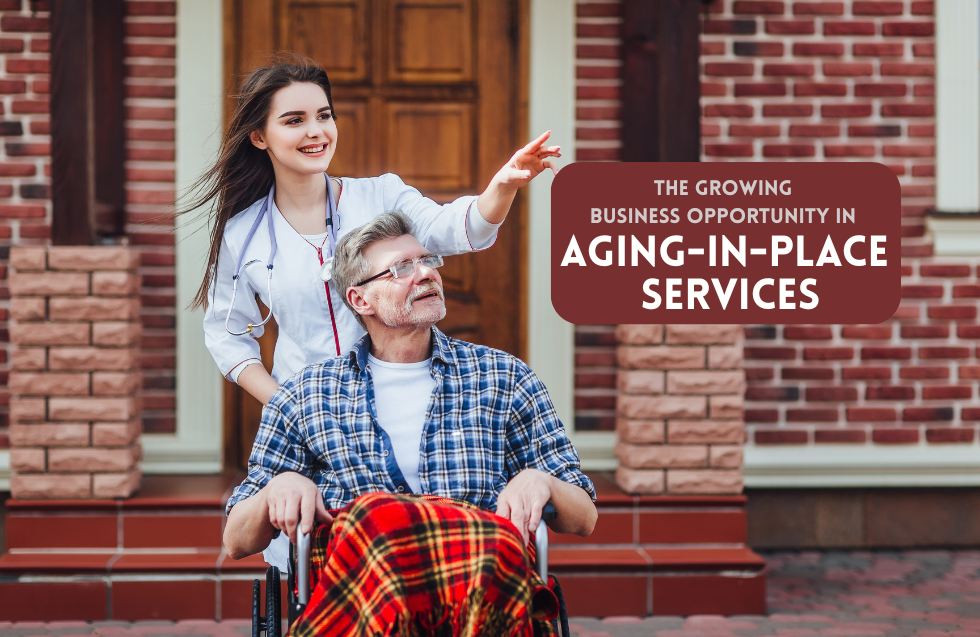Introduction: The Business Wake-Up Call
Someone new turns 65 every 7 seconds. In them nine out of ten don’t want nursing homes or senior living communities. They prefer to remain in place. That single choice is reshaping the landscape regarding housing, healthcare and technology. It is driving one of the fastest-growing sectors entrepreneurs can no longer walk past: aging-in-place.
An Expanding Global Market Based on Real Need
Demographics are shifting dramatically around the world. In 2050, over 1.5 billion people will be 65+ years old. In the United States, older people are expected to surpass children under 18 in population size by 2034. Aging in place has become a desire to a requirement with 60–77% of older adults wanting to remain in their homes and be aided by aging-in-place services instead of relocating to institutional living.
But only a minority of 10% homes in the U.S are now “age-ready,” having step-free entries and accessible bathrooms. That gap between intention and implementation is a genuine business opportunity for entrepreneurs to sell aging-in-place home modifications services from grab bars and ramps to universal design and green updates.
Technology Meets Compassion: Assistive and Smart Solutions
Behind every safe, comfortable aging-at-home situation is a smart environment. New products such as fall detection sensors, smart lighting, telehealth systems and embedded smart home devices are being integrated into new aging-in-place services that are no longer seen as just simply convenient and now are considered necessary.
This new market, referred to as gerontechnology or AgeTech, connects a plethora of disciplines, health, housing, communications, mobility, etc. to establish ambient environments for older adults. Entrepreneurs are harnessing AI, wearables and predictive monitoring in new, empathetic and innovative ways.
From Advisors to Innovators: Diverse Business Roles
The aging-in-place services ecosystem accommodates a wide range of business models:
- Home Safety Advisors: These trained specialists assist seniors with hazard assessments and solutions to live safely and independently.
- Home Modification Contractors: These contractors will install ramps, wider doors, lever handles and accessible bathrooms.
- Technology Providers: These specialists design and install smart home systems using sensors, telehealth connections and remote monitoring.
- Culturally Aligned Services: Customized design and care solutions focused on targeted communities such as ethnic minorities with limited options to culturally competent services.
Investments, IP and Innovation-All in Growth
The aging-in-place industry is not only large, it’s expanding rapidly.
- Global home care and aging-in-place market estimates put the figure at $151 billion with a CAGR of approximately 13%.
- The U.S. market alone was already worth $13.5 billion for aging-in-place and preventing falls in 2023. And the overall “silver economy” is poised to be a multi-trillion-dollar market by 2030.
In addition to investments, intellectual property in technology-enabled solutions for aging is becoming an effective differentiator. Recent analysis identifies a wide variety of patent opportunities within assistive and home health technologies.
Real-World Perspectives and Policy Drivers
On the ground, non-profits such as Habitat for Humanity assist seniors in modifying their homes for aging in place, marrying physical modifications with economic securities and emotional health. In the meantime, the village model captures the strength of community based aging-in-place strategies, where volunteers assist older adults with transportation and shopping, uniting safety with social connection.
Government incentives provide added impetus to this movement. In the United States, Medicaid waiver programs and the National Aging in Place Council provide financial incentives, grants, tax credits and policy support to businesses offering aging-in-place services and home modifications.
Across the world, the theory of the “silver dividend” foresees substantial gains for society from investing in health, infrastructure and age-friendliness of environments, new customer relationships and enhancements of quality life.
Why This Matters-Humanly and Strategically
For entrepreneurs, an investment in aging-in-place services is not just about the revenue. It’s about:
- Delivering dignity
- Supporting independence
- Enhancing well-being.
By way of warm home alterations, user-friendly technology or life-enriching advisory services, your business can actually change lives and create a sustainable enterprise.
FAQs About Aging-in-Place Services
Q1: Who do you call when an elderly individual needs assistance at home?
Families can start with local services, aging-in-place consultants or senior care agencies. Emergency support plans, home monitoring or recommendations for caregivers are generally offered by most companies providing aging-in-place services.
Q2: What are the strengths and weaknesses of aging in place?
The strengths are independence, emotional comfort and cost savings compared to institutionalization. Conversely, drawbacks can be safety hazards in non-senior-friendly homes, social isolation and the constant need for adjustments. Proper aging-in-place services reduce the negatives and increase quality of life.
Q3: What does research conducted by PubMed and NCBI reveal regarding aging in place?
PubMed and NCBI studies point out that aging in place enhances well-being, maintains community connections and lowers the cost of healthcare. They also point out the imperative of affordable housing, caregiving assistance and home health integration technology all at the heart of contemporary aging-in-place services.
Q4: What are the elderly care services provided through aging-in-place solutions?
These may encompass home health care, personal care, meal preparation, physical therapy, transportation and technology enabled monitoring. Most companies now package them under umbrella aging-in-place services.
Q5: How do you discuss the future with aging parents?
Begin with empathy. Structure the conversation about their aims: comfort, independence and dignity. Promote the aging in place services as solutions in order to remain home longer, not as deterrents or obstacles.
Q6: When do you know it’s time to get help for your older parents?
There could be multiple warning signs: falls, not taking medications, unpaid bills or even neglecting basic routines. This will usually be the time when families are contacted regarding aging-in-place services to add safety features, monitor health or provide in-home care.
Conclusion: Your Move, Your Moment
The aging-in-place services market is vast, lively and full of promise. From assistive technology and home automation innovation to contractor services and neighborhood models, there’s a niche and a market for each considerate entrepreneur. As the world’s 65+ population increases and wants to stay at home, the demand for these services will only get more pressing.
So the question is yours: In a world where our houses can do more than just house us where they can serve, watch over and understand us, how will you be part of making aging in place not merely possible, but empowering?












